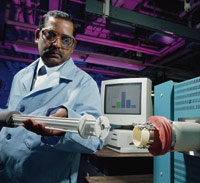 |
Explorer Magazine |
Membrane brings "hydrogen economy" one step closerScientists at Argonne have taken a big step toward the "hydrogen economy — the basic infrastructure required to make hydrogen an important source of fuel — with the development of a ceramic membrane that can isolate pure hydrogen gas. The device, called a hydrogen transport membrane, works by allowing only hydrogen from a flow of mixed gases to pass through. Hydrogen gas has applications in transportation, power generation, petroleum refining and food processing. Researcher Balu Balachandran, the manager of the ceramics section of Argonne's Energy Technology Division, says the membrane is not just a porous filter. "The membrane is composed of a special ceramic-metal composite with oxides of aluminum and zirconium, he said. "The only species that can go through it is hydrogen. This membrane is especially distinctive because it is effective at temperatures as high as 900 C, whereas other membranes cannot operate above 550 C. Balachandran said the preferred source of hydrogen is methane, a naturally occurring molecule that contains carbon and hydrogen. "Right now when companies dig for oil, with the crude oil comes natural gas, which is 96 percent methane. Some of it gets used as cooking gas or for other purposes, but the excess has to be burned in a remote area so it doesn't have a negative environmental impact, he said. Methane is considered a substantial contributor to global warming. But now the methane can be broken down into more useful components, using an oxygen membrane that itself won an R&D 100 Award when Argonne researchers developed it in 1995. Scientists use the oxygen membrane to combine methane with oxygen, creating a mixture of carbon monoxide and hydrogen called "syngas. Syngas reacts with steam to form carbon dioxide and more hydrogen. Scientists isolate the hydrogen by forcing the gas mixture over a hydrogen transport membrane. The hydrogen molecules break apart and pass through the membrane, leaving the carbon dioxide outside the membrane. The hydrogen gas, thus separated, is collected, while the carbon dioxide can be expelled or stored. Now that the Argonne team has created a working membrane in the laboratory, one of its next priorities is to build scaled-up versions for larger operations such as industrial plants. Balachandran's team is also working on improving the stability of the membrane in the presence of trace impurities, so it will still be effective even when there are contaminants in the gas. Finally, the researchers want to make the membrane stronger so it can withstand higher temperatures and pressures, conditions that improve the rate at which the hydrogen is transported out of the mixture. Balachandran developed the membrane with colleagues Stephen Dorris and Tae Lee, in collaboration with Gary Stiegel, Richard Dunst and John Winslow at the National Energy Technology Laboratory in Pittsburgh. |
|
|||||||
|
| ||||
|
| ||||
| ||||
